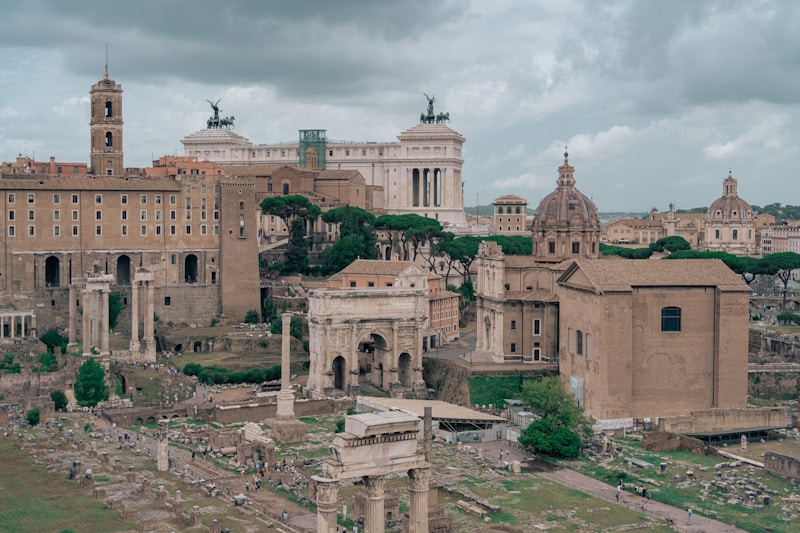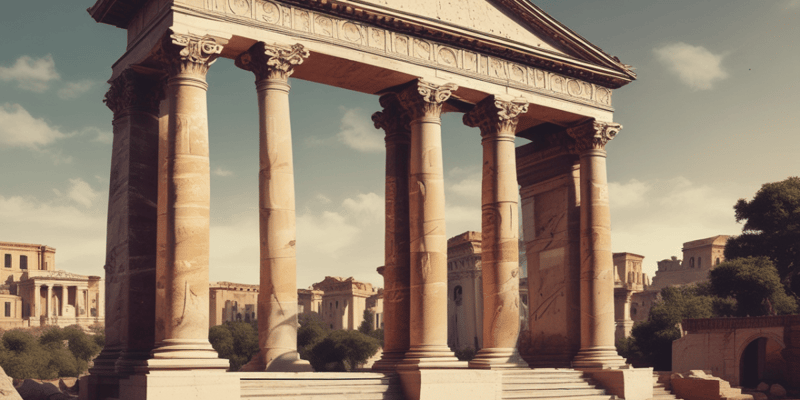Questions and Answers
What were the main themes of Roman painting?
Animals, still life, scenes from everyday life, and portraits
What was the main strength of Roman sculpture?
Portraiture
What was the innovation of Roman painting?
The development of landscapes
What was gold glass used for in Ancient Rome?
Signup and view all the answers
What was the Roman equivalent of an apartment building?
Signup and view all the answers
What was the main use of Roman mosaic before Christians started using it for religious images?
Signup and view all the answers
What were the main luxury arts in Ancient Rome?
Signup and view all the answers
What were the main achievements of Roman architecture?
Signup and view all the answers
What were Roman aqueducts used for?
Signup and view all the answers
Study Notes
Art in Ancient Rome and its territories includes architecture, painting, sculpture, mosaic work, metalwork, gem engraving, ivory carvings, and glasswork. Sculpture and figure painting were highly regarded, with a large body of sculpture surviving from the 1st century BC onward, and little remaining of painting. Roman pottery was a vast production of "fine wares" decorated with reliefs reflecting the latest taste. Roman artists borrowed heavily from Greek models, but also incorporated Etruscan, native Italic, and Egyptian visual culture. Roman art was a practical and eclectic pastiche, unlike the Greek reverence for great art. Roman art was commissioned, displayed, and owned in far greater quantities, and adapted to more uses than in Greek times. Roman painting themes include animals, still life, scenes from everyday life, portraits, and some mythological subjects. The innovation of Roman painting was the development of landscapes, in particular incorporating techniques of perspective. Roman still life subjects were often placed in illusionist niches or shelves and depicted a variety of everyday objects. Roman portraits were attached to burial mummies at the face, showing the head, or head and upper chest, viewed frontally. Gold glass was a technique for fixing a layer of gold leaf with a design between two fused layers of glass used to mark and decorate graves; most are Christian, though there are many pagan and a few Jewish examples.Overview of Roman Art and Architecture
-
Roman art was influenced by Greek and Etruscan art styles.
-
Early Roman sculpture was largely an extension of Hellenistic style, but with Roman elements.
-
Portraiture was the main strength of Roman sculpture, with busts representing ancestral figures.
-
Roman historical works were produced in relief, culminating in the great Roman triumphal columns with continuous narrative reliefs winding around them.
-
Roman art also included pottery, terracotta, glass, mosaic, metalwork, coins, and medals.
-
Luxury arts included fancy Roman glass in a great range of techniques, many smaller types of which were probably affordable to a good proportion of the Roman public.
-
Roman mosaic was mainly used for floors until Christians began to use it for large religious images on walls in their new large churches.
-
Metalwork was highly developed, and clearly an essential part of the homes of the rich.
-
Few Roman coins reach the artistic peaks of the best Greek coins, but they survive in vast numbers and their iconography and inscriptions form a crucial source for the study of Roman history.
-
Roman engineers developed methods for citybuilding on a grand scale, including the use of concrete, which allowed for massive buildings like the Pantheon and the Colosseum to be constructed.
-
Roman architecture is legendary for the durability of its construction, with many buildings still standing and some still in use.
-
Many ruins, including the Pantheon and the Colosseum, are still major tourist attractions today.Roman Architecture: Innovations, Achievements, and Legacy
-
Republican era architecture combined Greek and Etruscan elements, introduced the round temple and the curved arch, and produced the first concrete building, the Tabularium.
-
Roman power in the early empire led to the inauguration of wholesale leveling of slums to build grand palaces on the Palatine Hill and nearby areas, requiring advances in engineering methods and large scale design.
-
Roman buildings were then built in the commercial, political, and social grouping known as a forum with the Forum Romanum being the most famous, and the Colosseum being the greatest arena in the Roman world.
-
The five-story insula was the Roman equivalent of an apartment building, which housed tens of thousands of Romans.
-
During the reign of Trajan and Hadrian, Rome reached its artistic peak through massive building programs of monuments, meeting houses, gardens, aqueducts, baths, palaces, pavilions, sarcophagi, and temples.
-
Roman use of the arch, concrete building methods, and the dome permitted construction of vaulted ceilings and enabled the building of these public spaces and complexes, including the palaces, public baths, and basilicas of the "Golden Age" of the empire.
-
Outstanding examples of dome construction include the Pantheon, the Baths of Diocletian, and the Baths of Caracalla.
-
The height of the Pantheon's ceiling exactly equals the interior radius of the building, creating a hemispherical enclosure.
-
By the age of Constantine, the last great building programs in Rome took place, including the erection of the Arch of Constantine built near the Colosseum.
-
Roman aqueducts, also based on the arch, were commonplace in the empire and essential transporters of water to large urban areas.
-
The Pont du Gard and the aqueduct of Segovia are impressive examples of standing masonry remains of Roman aqueducts.
-
Roman architecture later served as inspirational models for architects of the Italian Renaissance, such as Brunelleschi.
Studying That Suits You
Use AI to generate personalized quizzes and flashcards to suit your learning preferences.
Description
Test your knowledge of ancient Roman art and architecture with our quiz! From the influence of Greek and Etruscan styles to the innovations of Roman engineering, this quiz covers the major achievements and legacy of Roman art and architecture. See if you can answer questions about Roman sculpture, painting, pottery, metalwork, and more. Challenge yourself with questions about famous Roman buildings and their construction methods, as well as the lasting impact of Roman architecture on later periods.




